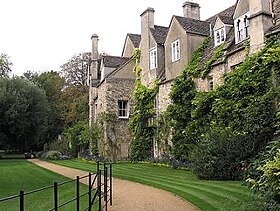Gloucester Hall, Oxford
| Gloucester College | |
|---|---|
 |
|
| University | University of Oxford |
| Location | Present day Worcester Street |
| Coordinates | 51°45′18″N 1°15′49″W / 51.75497°N 1.26370°WCoordinates: 51°45′18″N 1°15′49″W / 51.75497°N 1.26370°W |
| Established | 1283 |
| Closed | 1542 (annexed to St John's) 1714 (refounded as Worcester College) |
| Named for | St. Peter Abbey, Gloucester |
| Previous names | Gloucester Hall (1542) |
| Principal | see below |
| Map | |
Gloucester College, Oxford, was a Benedictine institution of the University of Oxford in Oxford, England, from the late 13th century until the Dissolution of the monasteries in the 16th century. It was never a typical college of the University, in that there was an internal division in the College, by staircase units, into parts where the monasteries sending monks had effective authority. The overall head was a Prior.
It later became Gloucester Hall, an annexe of St John's College and was again refounded in 1714 as Worcester College by Sir Thomas Cookes.
The initial foundation was from 1283. John Giffard gave a house, in Stockwell Street, Oxford. There was early friction with the local Carmelites. This was a donation to the Benedictines of the province of Canterbury. Control of the 13 places for monks fell to the abbey of St. Peter, Gloucester. The first prior was Henry de Heliun.
Pope Benedict XII in 1337 laid down, in the bull Pastor bonus, that 5% of Benedictine monks should be university students. But from the middle of the fourteenth century onwards there was an alternative, at the University of Cambridge. There were also the Benedictine Durham College, Oxford, and Canterbury College, Oxford. Even though the catchment area after 1337 included the Province of York, numbers of students were never high, one reason being the cost of living in Oxford (which the home monastery had to meet). After the Black Death, Gloucester College was closed for a time. In 1537 it was found to have 32 students.
...
Wikipedia

